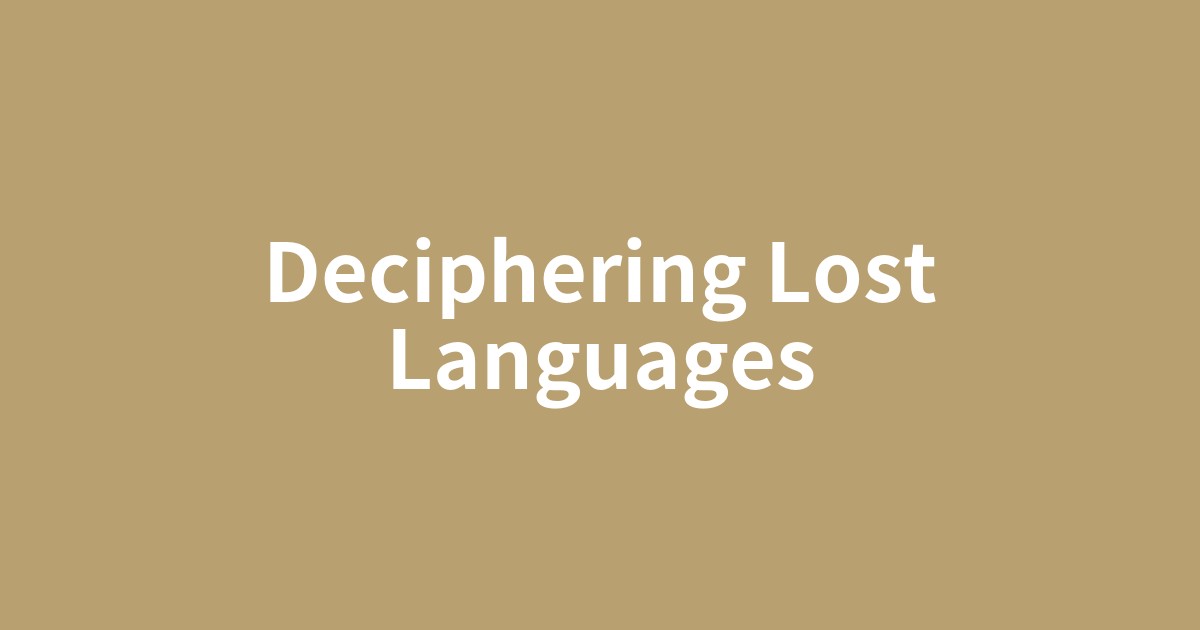このページは、歴史や文化の物語を楽しみながら、その文脈の中で重要な英単語を自然に学ぶための学習コンテンツです。各セクションの下にあるボタンで、いつでも日本語と英語を切り替えることができます。背景知識を日本語で学んだ後、英語の本文を読むことで、より深い理解と語彙力の向上を目指します。

古代の石碑などに残された、忘れ去られた言語。考古学者や言語学者が、パズルのように謎を解き明かしていく、知的なadventure(冒険)。
この記事で抑えるべきポイント
- ✓ロゼッタストーンがエジプト聖刻文字(ヒエログリフ)解読の突破口となったのは、既知のギリシャ語を含む3つの言語で同じ内容が記されていたためである、という構造的な理解。
- ✓言語解読とは、天才的なひらめきだけでなく、比較言語学や暗号解読にも似た、地道な仮説検証を繰り返す科学的な探求プロセスであるという点。
- ✓線文字Bの解読が、ミケーネ文明がギリシャ人の文明であったことを証明し、古代ギリシャ史を数百年遡らせるという、歴史学上の大きな発見につながったこと。
- ✓解読されたテキストは、王の功績だけでなく、古代社会の経済活動や人々の生活といった、より具体的な姿を現代に伝える貴重な一次資料としての価値を持つこと。
失われた言語を解読する ― ロゼッタストーンから線文字Bまで
もし、目の前にある石碑に刻まれた文字が、誰も読めない失われた言語だったら? あなたはそこに何が書かれているか、知りたいと思わないでしょうか。この記事は、ロゼッタストーンや線文字Bといった古代の謎を、偉大な探究者たちがどのように解き明かしていったのか、その知的な冒険(adventure)を追体験する旅です。
Deciphering Lost Languages: From the Rosetta Stone to Linear B
What if the characters carved on a stone tablet in front of you were in a lost language that no one could read? Wouldn't you want to know what it says? This article is a journey to relive the intellectual adventure of how great minds unraveled ancient mysteries like the Rosetta Stone and Linear B.
解読の鍵、ロゼッタストーン
物語は1799年、ナポレオン軍がエジプトで偶然発見した一枚の石板から始まります。ロゼッタストーンとして知られるこの貴重な「人工遺物(artifact)」には、同じ内容の文章が3つの異なる文字で記されていました。上段には古代エジプトの聖刻文字ヒエログリフ、中段には民衆文字デモティック、そして下段には、当時の学者たちが読むことのできたギリシャ語。この3言語併記の「碑文(inscription)」こそが、長らく謎に包まれていたヒエログリフ解読への扉を開く鍵となったのです。フランスの若き天才「言語学者(linguist)」、ジャン=フランソワ・シャンポリオンは、ギリシャ語の固有名詞「プトレマイオス」を手がかりに、ヒエログリフが単なる絵文字ではなく、音を表す表音文字の性質も持つことを突き止めました。これは、地道な比較と仮説検証の末に成し遂げられた、歴史的な解読(decipher)でした。
The Key to Decipherment, the Rosetta Stone
The story begins in 1799, when Napoleon's army in Egypt stumbled upon a stone slab. This precious artifact, known as the Rosetta Stone, bore the same text written in three different scripts. The top section was in ancient Egyptian hieroglyphs, the middle in Demotic script, and the bottom in Greek, a language scholars of the time could read. This trilingual inscription was the key that unlocked the door to deciphering the long-mysterious hieroglyphs. A young French genius and linguist, Jean-François Champollion, used the Greek proper nouns "Ptolemaios" and "Kleopatra" as clues to discover that hieroglyphs were not just pictograms but also had phonetic properties representing sounds. This was a historic decipherment, achieved through painstaking comparison and hypothesis testing.
ミケーネ文明の謎 ― 線文字Bへの挑戦
舞台は19世紀末のエーゲ海、クレタ島へ移ります。イギリスの「考古学者(archaeologist)」アーサー・エヴァンズは、伝説のミノス王の宮殿とされるクノッソス遺跡を発掘し、奇妙な文字が刻まれた数千枚もの粘土板を発見しました。彼はこれらを古い年代の「線文字A」と、より新しい「線文字B」に分類します。線文字Aは今なお未解読ですが、線文字Bは多くの考古学者や言語学者の挑戦心をかき立てました。中でも異彩を放っていたのが、建築家であったマイケル・ヴェントリスです。彼は専門外でありながら、少年時代にエヴァンズの講演を聞いて以来、線文字Bの解読に生涯を捧げるほどの情熱を燃やし続けました。
The Mystery of Mycenaean Civilization: The Challenge of Linear B
The scene shifts to the Aegean Sea at the end of the 19th century, on the island of Crete. The British archaeologist Sir Arthur Evans excavated the Palace of Knossos, believed to be the legendary King Minos's palace, and discovered thousands of clay tablets inscribed with strange characters. He classified them into the older "Linear A" and the more recent "Linear B." While Linear A remains undeciphered to this day, Linear B stirred the intellectual curiosity of many archaeologists and linguists. Among them, Michael Ventris, an architect, stood out. Though an amateur in the field, he had been passionate about deciphering Linear B ever since hearing a lecture by Evans as a boy, a passion he pursued for the rest of his life.
「それはギリシャ語だった」― 歴史を書き換えた発見
ヴェントリスは、線文字Bが、文字一つ一つが音節を表す音節文字(syllabary)であると仮定し、統計的な分析を進めました。そして1952年、彼はついに歴史を揺るがす結論に達します。線文字Bは未知の言語ではなく、ホメロスの叙事詩よりも数世紀古い、初期のギリシャ語を表記したものであったのです。この発見は、ギリシャ本土で栄えたミケーネ「文明(civilization)」が、ギリシャ語を話す人々によって担われていたことを決定づけるものでした。それまで神話の世界の出来事とされていたトロイア戦争の時代と、歴史時代の古代ギリシャとが、言語によって直接結びついた瞬間であり、ギリシャの歴史を一気に数百年も遡らせる大発見となりました。
"It Was Greek": A Discovery That Rewrote History
Ventris hypothesized that Linear B was a syllabary, where each character represents a syllable, and proceeded with statistical analysis. Then, in 1952, he reached a conclusion that would shake the foundations of history. Linear B was not an unknown language, but an early form of Greek, centuries older than Homer's epics. This discovery definitively proved that the Mycenaean civilization, which flourished on the Greek mainland, was run by Greek-speaking people. It was the moment that directly linked the era of the Trojan War, previously considered mythical, to the historical world of ancient Greece, pushing back Greek history by several hundred years.
文字が語る古代のリアルな姿
では、解読された粘土板には何が書かれていたのでしょうか。人々は英雄の武勇伝や壮大な神話を期待しましたが、その内容は驚くほど現実的なものでした。線文字Bで書かれた「碑文(inscription)」のほとんどは、宮殿の倉庫に保管されていた物品の「目録(inventory)」だったのです。例えば、「羊 100頭」「三脚付きの青銅の釜 2個」「戦車 1台」といった、税や貢物、軍備に関する記録です。これらの「人工遺物(artifact)」は、王の功績を称える記念碑とは異なり、ミケーネ文明の経済活動や社会システム、人々の生活のリアルな姿を現代に伝えるタイムカプセルでした。失われた文字の解読は、歴史の空白を埋めるだけでなく、古代社会に生きた人々の息づかいそのものを蘇らせるのです。
The Texts Reveal the Reality of the Ancient World
So, what was written on the deciphered tablets? People expected heroic tales and grand myths, but the content was surprisingly practical. Most of the inscriptions written in Linear B were an inventory of goods stored in the palace warehouses. For example, records of taxes, tributes, and armaments, such as "100 sheep," "2 bronze cauldrons with three feet," and "1 chariot." Unlike monuments praising a king's achievements, these artifacts were time capsules that convey the reality of the Mycenaean civilization's economic activities, social systems, and daily life. The decipherment of lost languages not only fills in the gaps of history but also brings back to life the very breath of the people who lived in ancient societies.
過去との対話は続く
ロゼッタストーンと線文字Bの解読物語は、単なる言語学上の成果ではありません。それは、過去の遺産を前にした人類の飽くなき知的好奇心と、地道な探究心の勝利の物語です。シャンポリオンやヴェントリスのような探究者たちの情熱がなければ、古代文明の多くは永遠に沈黙を守り続けていたでしょう。そして今なお、線文字Aやインダス文字など、私たちを誘う未解読のメッセージが世界には残されています。過去との対話である言語解読という知の冒険は、これからも続いていくのです。
The Dialogue with the Past Continues
The story of the decipherment of the Rosetta Stone and Linear B is more than just a linguistic achievement. It is a tale of humanity's insatiable intellectual curiosity and the triumph of persistent inquiry when faced with the legacy of the past. Without the passion of explorers like Champollion and Ventris, many ancient civilizations would have remained silent forever. And even now, undeciphered messages like Linear A and the Indus script remain in the world, beckoning us. The intellectual adventure of deciphering languages, a dialogue with the past, continues on.
テーマを理解する重要単語
archaeologist
「考古学者」。遺跡や遺物の発掘・調査を通じて、過去の人類の活動や文化を研究する専門家です。クノッソス遺跡を発掘し、線文字が書かれた粘土板を発見したアーサー・エヴァンズがその典型です。言語解読の物語が、まず考古学的な発見から始まることを理解する上で重要な単語です。
文脈での用例:
The archaeologist carefully brushed the dirt from the ancient pottery.
その考古学者は古代の土器から慎重に土を払い落とした。
legacy
「遺産」。先人や過去の時代から受け継がれた物事や文化を指します。この記事では、ロゼッタストーンや粘土板が、単なる過去の遺物ではなく、現代に生きる私たちに問いかける「過去からの遺産 (legacy of the past)」として描かれています。解読行為が、この遺産との対話であることを示唆する重要な単語です。
文脈での用例:
The artist left behind a legacy of incredible paintings.
その芸術家は素晴らしい絵画という遺産を残しました。
inquiry
「探究、調査」。真実や知識を求める知的な探求活動を指します。記事の結論部分で「地道な探究心 (persistent inquiry)」という言葉で、シャンポリオンやヴェントリスの姿勢を称えています。この単語は、言語解読が単なるひらめきではなく、情熱に支えられた粘り強い探究の賜物であることを象徴しています。
文脈での用例:
Scientific inquiry begins with careful observation and questioning.
科学的探求は、注意深い観察と問いかけから始まります。
civilization
「文明」。高度な社会組織、文化、技術などを持つ人間社会の発展段階を指します。この記事では、ミケーネ文明やエジプト文明といった壮大な歴史の舞台設定として登場します。言語の解読が、単なる文字の謎解きに留まらず、一つの「文明」全体の姿を明らかにする壮大な営みであることを示しています。
文脈での用例:
Ancient Egypt was one of the world's earliest civilizations.
古代エジプトは世界最古の文明の一つでした。
artifact
「人工遺物」。人間によって作られた、歴史的・文化的な価値を持つ物品のことです。この記事では、ロゼッタストーンや粘土板が、単なる石や土くれではなく、過去の文明を物語る貴重な「人工遺物」であることが強調されています。考古学の文脈を理解する上で欠かせない基本単語と言えるでしょう。
文脈での用例:
The museum displays various artifacts from the Egyptian pyramids.
その博物館はエジプトのピラミッドから出土した様々な遺物を展示している。
linguist
「言語学者」。言語の構造や歴史、社会との関わりなどを科学的に研究する専門家です。この記事では、ヒエログリフを解読したシャンポリオンがその代表例として登場します。彼の業績は、言語学という学問が歴史の謎を解き明かす上でいかに強力な武器となるかを鮮やかに示しています。
文脈での用例:
As a linguist, she is interested in the structure of ancient languages.
言語学者として、彼女は古代言語の構造に興味を持っている。
inscription
「碑文、刻まれた文字」。石や金属、粘土板などに記された文字を指します。この記事では、ロゼッタストーンの3言語併記の碑文や、線文字Bが書かれた粘土板など、解読の対象となる具体的な「文字資料」そのものです。この単語は、古代からのメッセージが物理的な形で現代に伝わっていることを示唆しています。
文脈での用例:
The archaeologist deciphered the ancient inscription on the stone tablet.
その考古学者は、石板に刻まれた古代の碑文を解読した。
inventory
「目録」。倉庫にある物品などを一覧にした記録のことです。解読された線文字Bの内容が、英雄譚ではなく「羊100頭」といった宮殿の物品「目録」だったという事実は、この記事のハイライトの一つです。古代社会のリアルで実務的な側面を浮き彫りにする、非常に重要な単語と言えるでしょう。
文脈での用例:
We do a full inventory of the store's stock once a year.
私たちは年に一度、店の全在庫の棚卸しをします。
unravel
「(謎などを)解き明かす」。この記事の冒頭で「古代の謎を解き明かす (unravel ancient mysteries)」と使われており、複雑で難解な問題を一つ一つ丁寧に解決していくニュアンスを持ちます。`decipher`が技術的な解読を指すのに対し、より物語的な「謎解き」のイメージを喚起する単語です。
文脈での用例:
The detective tried to unravel the mystery behind the crime.
その探偵は、犯罪の裏にある謎を解明しようとした。
decipher
「解読する」。この記事の核心的な行為そのものを指す最重要単語です。ロゼッタストーンのヒエログリフや線文字Bのような、未知の文字体系の意味を読み解くという知的な挑戦を象徴しています。この単語を理解することで、シャンポリオンやヴェントリスが成し遂げた偉業の重みがより深く感じられるでしょう。
文脈での用例:
Scientists are trying to decipher the genetic code of this virus.
科学者たちはこのウイルスの遺伝子コードを解読しようとしている。
syllabary
「音節文字体系」。日本語の仮名のように、一つ一つの文字が「音節(シラブル)」を表す文字体系のことです。ヴェントリスが線文字Bを「音節文字」だと仮定したことが、解読の大きな突破口となりました。文字の種類の違いを理解することは、解読プロセスの核心に触れるための鍵となります。
文脈での用例:
Japanese Hiragana and Katakana are examples of a syllabary.
日本語のひらがなとカタカナは音節文字体系の例である。
trilingual
「3言語使用の」。ロゼッタストーンがヒエログリフ、デモティック、ギリシャ語の「3言語併記」であったことを的確に表現する単語です。この石碑がなぜ解読の鍵となったのか、その本質的な特徴を一言で示しています。この単語を知ることで、ロゼッタストーンの歴史的重要性がいっそう明確に理解できます。
文脈での用例:
The Rosetta Stone is famous for its trilingual inscription.
ロゼッタストーンは3言語で書かれた碑文で有名だ。